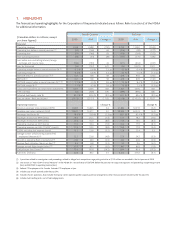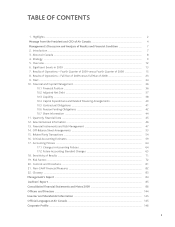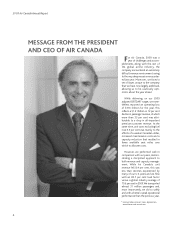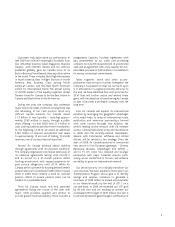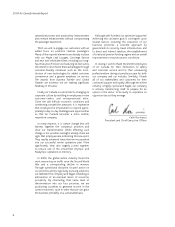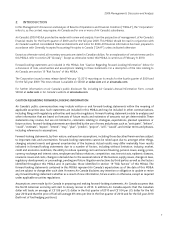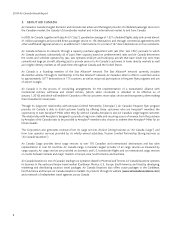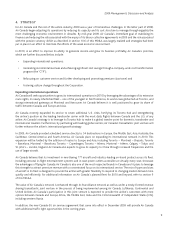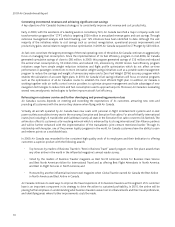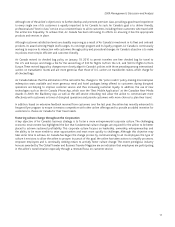Air Canada 2009 Annual Report Download - page 9
Download and view the complete annual report
Please find page 9 of the 2009 Air Canada annual report below. You can navigate through the pages in the report by either clicking on the pages listed below, or by using the keyword search tool below to find specific information within the annual report.2009 Management’s Discussion and Analysis
9
4. STRATEGY
For Air Canada and the rest of the airline industry, 2009 was a year of tremendous challenges. In the latter part of 2008,
Air Canada began adjusting its operations by reducing its capacity and its cost structure to manage through arguably the
most challenging economic environment in decades. By mid-year 2009, Air Canada’s immediate goal of stabilizing its
fi nances and reducing the risk associated with the expiry of its labour collective agreements in 2009 and the risk associated
with the pension solvency defi cit as described in section 10.6 of this MD&A was largely realized and strategies had been
put in place in an effort to minimize the effects of the weak economic environment.
In 2010, in an effort to improve its ability to generate income and grow its business profi tably, Air Canada’s priorities,
which are further discussed below, include:
• Expanding international operations;
• Generating incremental revenues and achieving signifi cant cost savings through a company-wide cost transformation
program (the “CTP”);
• Refocusing on customer service and further developing and promoting premium class travel; and
• Fostering culture change throughout the Corporation.
Expanding international operations
Air Canada will seek opportunities to grow its international operations in 2010 by leveraging the advantages of its extensive
route rights, its newly refurbished fl eet – one of the youngest in North America, its world-class global hub at Toronto, and
strong international gateways at Montreal and Vancouver. Air Canada believes it is well positioned to grow its share of
traffi c between Canada, and Europe and Asia.
Air Canada recently expanded its service to seven additional U.S. cities, fortifying its Toronto hub and strengthening
the airline’s position as the leading transborder carrier with the most daily fl ights between Canada and the U.S. of any
airline. Air Canada’s strategy is to leverage its Toronto hub to make it a global transfer point for domestic, transborder and
international travelers. Furthermore, by partnering with leading global carriers, Air Canada’s transatlantic joint venture will
further enhance the airline’s international growth strategy.
In 2009, Air Canada provided scheduled service directly to 54 destinations in Europe, the Middle East, Asia, Australia, the
Caribbean, Central America and South America. Air Canada plans on expanding its international network in 2010. This
expansion will be fuelled by the addition of routes to Europe and Asia, including Toronto – Montreal – Brussels, Toronto
– Barcelona, Montreal – Barcelona, Toronto – Copenhagen, Toronto – Athens, Montreal – Athens, Calgary – Tokyo and
St. John’s – London, England. Air Canada also expects to grow its capacity to China through increased frequencies and the
use of larger aircraft.
Air Canada believes that its investment in new Boeing 777 aircraft and industry-leading on-board product across its fl eet,
including personal in-fl ight entertainment systems and in-seat power outlets accessible at virtually every seat, showcase
the advantages of fl ying Air Canada. Air Canada is also one of the most respected brands in Canada and it plans to leverage
this strength to attract premium revenue with a concentrated focus on its international service. The mix of types and sizes
of aircraft in its fl eet is designed to provide the airline with greater fl exibility to respond to changing market demand more
quickly and effi ciently. For additional information on Air Canada’s planned fl eet for 2010 and beyond, refer to section 9
of this MD&A.
The value of Air Canada’s network is enhanced through its Star Alliance network as well as under a newly-formed revenue
sharing transatlantic joint venture in the process of being implemented among Air Canada, Lufthansa, Continental and
United Airlines. Air Canada’s participation in this joint venture is expected to provide the airline’s customers with more
options between Canada and Europe, Africa, the Middle East, India and the Commonwealth of Independent States (CIS),
including western Russia.
In addition, the new Canada-EU air services agreement that came into effect in December 2009 will provide Air Canada
with additional traffi c right opportunities in the coming years.


